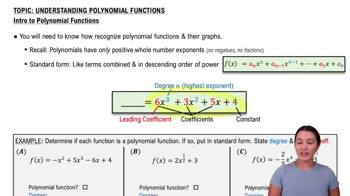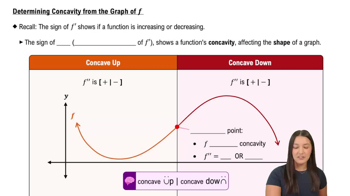Table of contents
- 0. Functions7h 52m
- Introduction to Functions16m
- Piecewise Functions10m
- Properties of Functions9m
- Common Functions1h 8m
- Transformations5m
- Combining Functions27m
- Exponent rules32m
- Exponential Functions28m
- Logarithmic Functions24m
- Properties of Logarithms34m
- Exponential & Logarithmic Equations35m
- Introduction to Trigonometric Functions38m
- Graphs of Trigonometric Functions44m
- Trigonometric Identities47m
- Inverse Trigonometric Functions48m
- 1. Limits and Continuity2h 2m
- 2. Intro to Derivatives1h 33m
- 3. Techniques of Differentiation3h 18m
- 4. Applications of Derivatives2h 38m
- 5. Graphical Applications of Derivatives6h 2m
- 6. Derivatives of Inverse, Exponential, & Logarithmic Functions2h 37m
- 7. Antiderivatives & Indefinite Integrals1h 26m
- 8. Definite Integrals4h 44m
- 9. Graphical Applications of Integrals2h 27m
- 10. Physics Applications of Integrals 2h 22m
5. Graphical Applications of Derivatives
Concavity
Problem 116
Textbook Question
Concavity of parabolas Consider the general parabola described by the function f(x) = ax² + bx + c. For what values of a, b, and c is f concave up? For what values of a, b, and c is f concave down?
 Verified step by step guidance
Verified step by step guidance1
To determine the concavity of the parabola described by f(x) = ax² + bx + c, we need to examine the second derivative of the function. The second derivative provides information about the curvature of the graph.
First, find the first derivative of f(x). The first derivative, f'(x), is obtained by differentiating f(x) with respect to x: f'(x) = 2ax + b.
Next, find the second derivative, f''(x), by differentiating f'(x) with respect to x: f''(x) = 2a.
The concavity of the parabola is determined by the sign of the second derivative, f''(x). If f''(x) > 0, the parabola is concave up. If f''(x) < 0, the parabola is concave down.
Since f''(x) = 2a, the parabola is concave up when a > 0 and concave down when a < 0. The values of b and c do not affect the concavity, as they do not appear in the second derivative.
 Verified video answer for a similar problem:
Verified video answer for a similar problem:This video solution was recommended by our tutors as helpful for the problem above
Video duration:
5mPlay a video:
Was this helpful?
Key Concepts
Here are the essential concepts you must grasp in order to answer the question correctly.
Concavity
Concavity refers to the direction in which a curve bends. A function is concave up if its graph opens upwards, resembling a cup, and concave down if it opens downwards, resembling a cap. This behavior is determined by the second derivative of the function; if the second derivative is positive, the function is concave up, and if it is negative, the function is concave down.
Recommended video:

Determining Concavity Given a Function
Second Derivative Test
The second derivative test is a method used to determine the concavity of a function. For a function f(x), the second derivative, denoted as f''(x), provides information about the curvature of the graph. If f''(x) > 0 for all x in an interval, the function is concave up on that interval; if f''(x) < 0, it is concave down. This test is crucial for analyzing the behavior of polynomial functions like parabolas.
Recommended video:

The Second Derivative Test: Finding Local Extrema
Quadratic Function
A quadratic function is a polynomial function of degree two, typically expressed in the form f(x) = ax² + bx + c, where a, b, and c are constants. The coefficient 'a' determines the direction of the parabola: if a > 0, the parabola opens upwards (concave up), and if a < 0, it opens downwards (concave down). Understanding the role of 'a' is essential for determining the concavity of the parabola.
Recommended video:

Introduction to Polynomial Functions

 6:38m
6:38mWatch next
Master Determining Concavity from the Graph of f with a bite sized video explanation from Callie
Start learningRelated Videos
Related Practice






